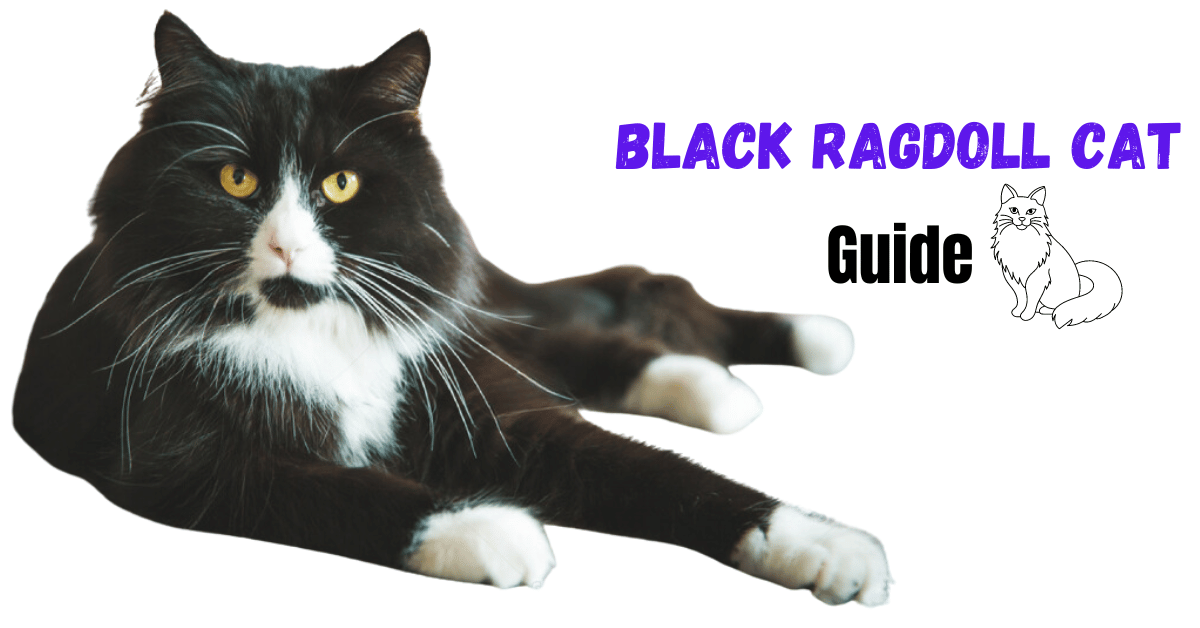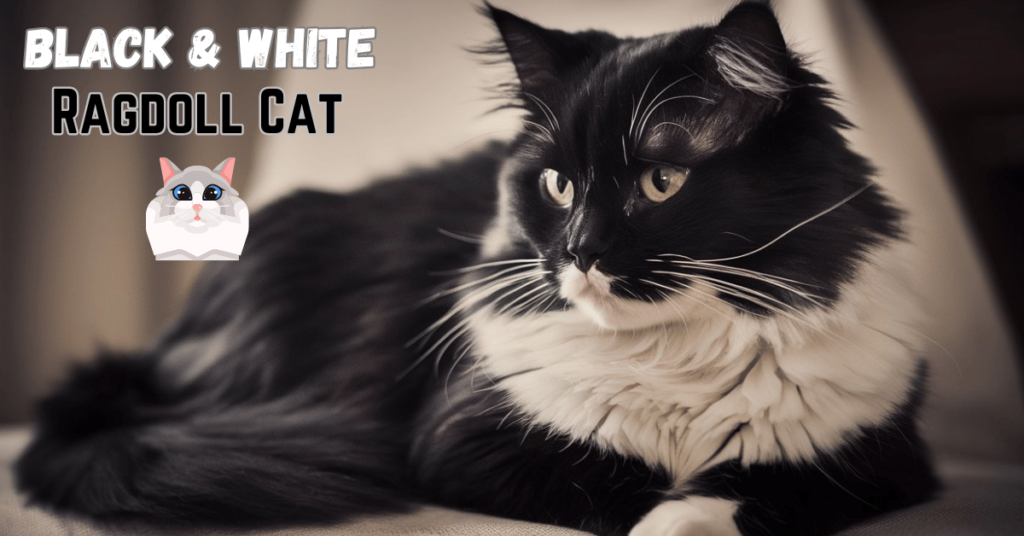This post contains affiliate links and I will be compensated if you make a purchase after clicking on my links.
The Mystique of the Black Ragdoll Cat
Ragdoll cats are renowned for their plush coats and captivating demeanor, especially their unique tendency to go limp when picked up—a characteristic that has affectionately earned them the name “Ragdoll.” However, nestled within this beloved breed is a lesser-known and intriguing variant: the Black Ragdoll cat.
These cats do not sport the traditional blue eyes or pointed color patterns typical of their lighter-furred counterparts. Instead, Black Ragdolls feature sleek, dark coats and may have green, amber, or even bi-colored eyes, adding an air of mystery to their appearance.
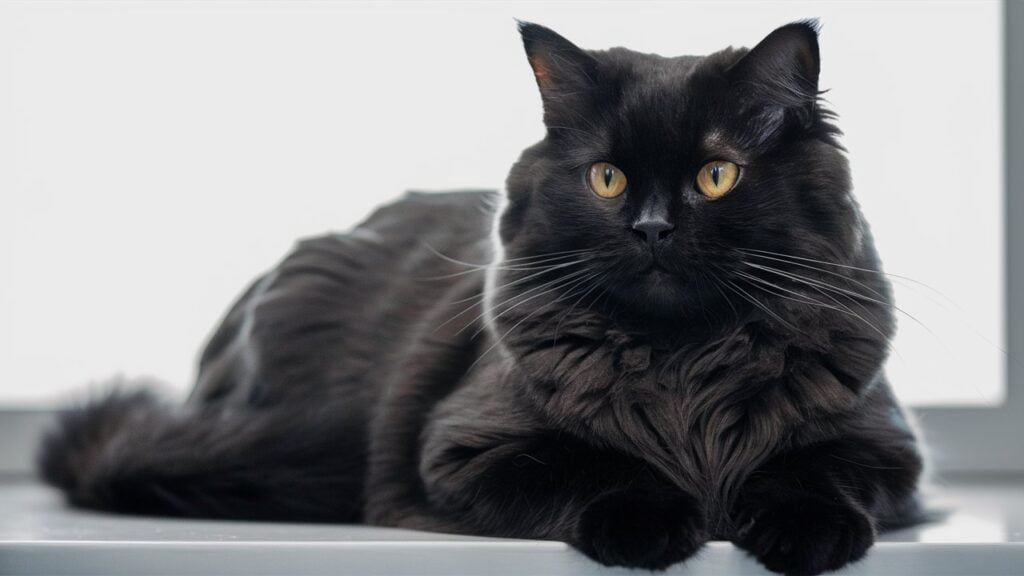
While they lack the traditional Ragdoll points—those distinct colorations on the mask, ears, eyes, legs, and tail—they possess all the hallmark traits of the breed, including their large size, silky coat texture, and notably docile personality.
The Origins of the Black Ragdoll Cat
The intriguing story of the Black Ragdoll cat traces back to the colorful era of the 1960s in Riverside, California, where a visionary breeder named Ann Baker played a pivotal role in the breed’s inception.
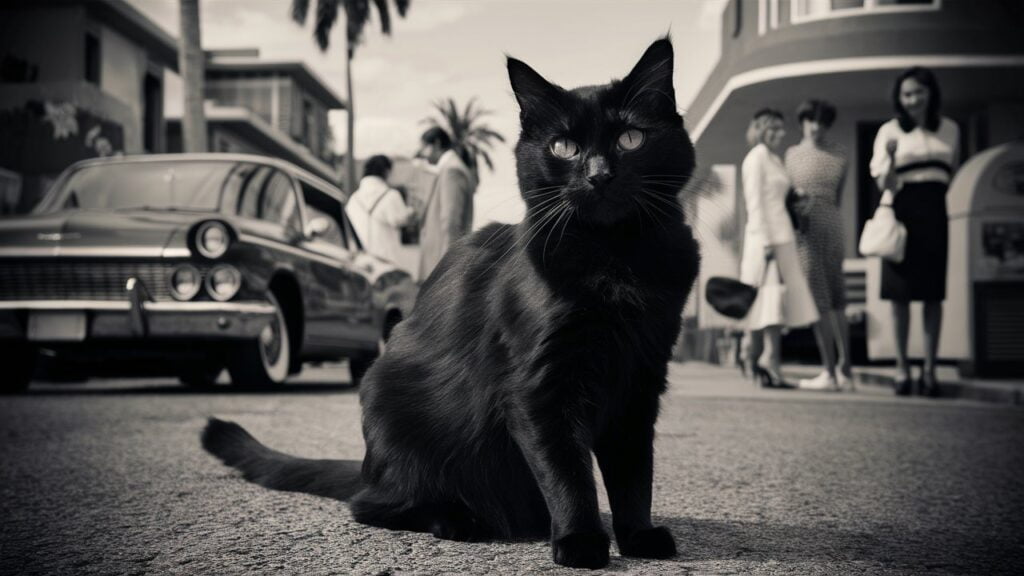
Among her first litters was a distinctive cat named Blackie, a wholly black Ragdoll whose unique appearance set him apart from the traditionally pointed Ragdolls. Blackie’s solid, shadowy coat marked the beginning of a new lineage within the Ragdoll breed, one that would spark both admiration and controversy in the cat fancier community.
Ann Baker’s approach to breeding was characterized by strict control over her program, leading to disputes with other breeders such as Denny and Laura Dayton. These breeders have been credited with shaping the Ragdoll breed as it is known today, which does not include the color black. Despite these challenges, Blackie’s legacy continued to grow, siring several litters that would carry on the traits of the solid black coat.
Genetic Makeup and Breed Recognition
Black Ragdoll cats do not display the traditional Ragdoll points, yet they possess the underlying genes that can produce these markings. This genetic setup allows for a unique breeding outcome: even when two Black Ragdolls are mated, there’s a chance that some kittens in the litter will exhibit the pointed patterns characteristic of the breed.
Similarly, breeding a Black Ragdoll with a traditionally pointed Ragdoll often results in a mix of pointed and solid-colored kittens, highlighting the unpredictable beauty of their genetics.
Despite their striking appearance, Black Ragdolls face significant challenges in cat competitions. Major cat-fancying organizations, such as The Cat Fanciers’ Association (CFA) and The International Cat Association (TICA), have stringent standards that exclude solid colors like black from breed-specific shows.
These standards typically require Ragdolls to have blue eyes, whereas many Black Ragdolls feature green, amber, or bi-colored eyes, adding another layer of complexity to their show eligibility. As a result, Black Ragdolls can only be registered and shown as household pets, not in breed categories.
Fact: Most standards, including the Cat Fanciers Association (CFA), say that, on top of blue eyes, Ragdoll cats must come in Bi-Color, Van, Colorpoint, or Mitted patterns. Their points (mask, paws, and ears) should be seal, blue, chocolate, lilac, red, or cream. Tortie and lynx patterns are welcome, too!
Physical Traits of the Black Ragdoll
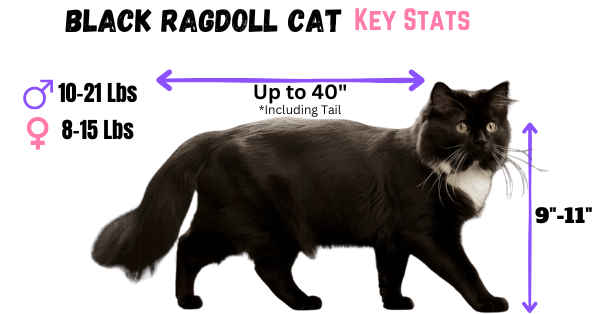
Black Ragdoll cats, distinguished by their uniform coloration, range from deep charcoal to glossy jet black. These large-sized felines have a robust build typical of the breed, with weights spanning 8-21 pounds and heights of 9-11 inches at the shoulder. Males are generally heavier, showcasing the breed’s impressive stature.
Black Ragdolls also exhibit a slower pace of maturity compared to many other cat breeds. It takes about four years for them to fully develop into their majestic stature, complete with a luxurious coat that includes extra fluff around their necks, known as a ruff, and their legs, often referred to as pantaloons.
Fact: This extended period of growth allows their personalities to unfold gradually, revealing new layers of charm and character as they age.
The Personality and Temperament of the Black Ragdoll
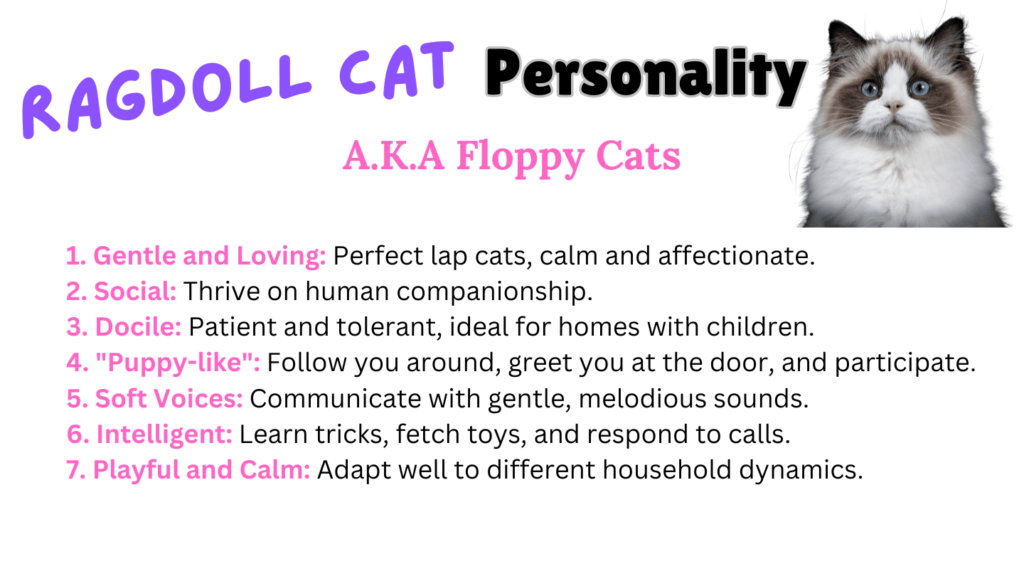
Black Ragdoll cats blend serene calm with playful curiosity, embodying the perfect lap cat with their gentle demeanor and love for cozy snuggles. These cats are not just about relaxation; they exhibit a lively curiosity and enjoy exploring their surroundings, often accompanying their owners throughout the home with a sociable and interactive flair.
Renowned for their friendly nature, Black Ragdolls are active participants in family life, making them excellent companions for households with children or other pets. They adapt seamlessly to busy environments, often becoming the center of attention as they greet guests with elegance and ease.
Despite their laid-back appearance, Black Ragdolls are exceptionally intelligent. They thrive on interactive play that stimulates their minds, such as puzzle feeders and toys that mimic prey movements. This sharp intellect also makes them quick to learn tricks and commands, enhancing their charm and making them highly trainable.
Caring for Your Black Ragdoll
Caring for a Black Ragdoll cat involves attention to their diet, exercise, and health management to ensure they live a full, healthy life. Here’s how you can provide the best care for these majestic felines:
Nutritional Needs
Black Ragdolls thrive on a diet rich in high-protein wet food. This type of food not only caters to their carnivorous nature but also provides the hydration they need, which is less prevalent in dry foods.
During their growth phase, young Black Ragdolls may require increased food quantities to support their development. As they mature, it’s important to adjust their food intake to prevent overfeeding and ensure they maintain a healthy weight.
Try this Ragdoll Cat breed Weight Calculator to calculate the ideal weight based on age and gender>>
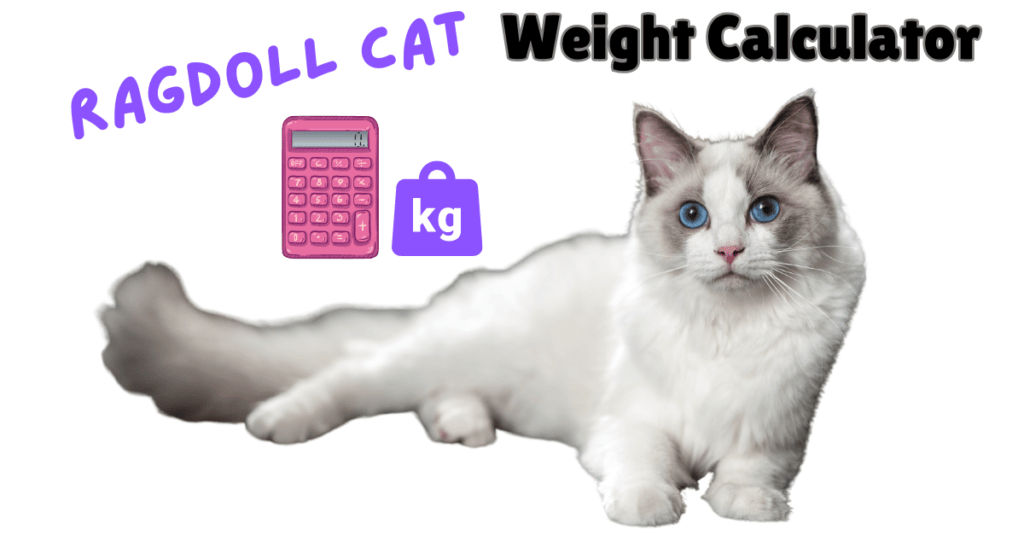
Exercise
Regular exercise is crucial for keeping your Black Ragdoll healthy and happy. Engage them in daily play sessions to keep them physically fit and mentally sharp. Simple activities like a game of fetch or chasing a laser pointer can significantly contribute to their well-being.
Aim for 30 to 60 minutes of playtime daily, split between interactive play with you and solo activities. This not only prevents obesity but also keeps them agile and content.
Health Management
To ensure your Black Ragdoll enjoys a long and healthy life, staying proactive with their health management is key. Here’s a list of common health issues to watch for, emphasizing the importance of regular veterinary care:
- Hypertrophic Cardiomyopathy: This heart condition is the most common form of heart disease in cats, where the heart muscle thickens.
- Mucopolysaccharidosis: A less common but serious metabolic disorder that affects the cat’s ability to break down certain molecules. It’s important for breeders to screen for this condition to prevent it from passing to offspring.
- Polycystic Kidney Disease (PKD): This condition leads to multiple fluid-filled cysts developing on the kidneys from a young age, growing as the cat matures.
- Bladder Stones: These can cause discomfort and urinary blockages.
Choosing a reputable breeder who conducts thorough health screenings on their kittens is crucial. Regular health check-ups are essential not only for early detection of these conditions but also for maintaining your cat’s overall well-being.
Fact: Though Ragdolls typically have a lifespan of 12-15 years, a study from Sweden found that 63% don’t reach their 10th birthday. However, with proper care, regular health checks, and a nurturing environment, many Ragdolls can live longer and healthier lives.
Grooming Your Black Ragdoll Cat
The grooming requirements for Black Ragdoll cats are consistent with those for any other Ragdoll. Proper grooming is crucial to maintain the health and happiness of your Black Ragdoll.
Here’s how to ensure they always look their best:
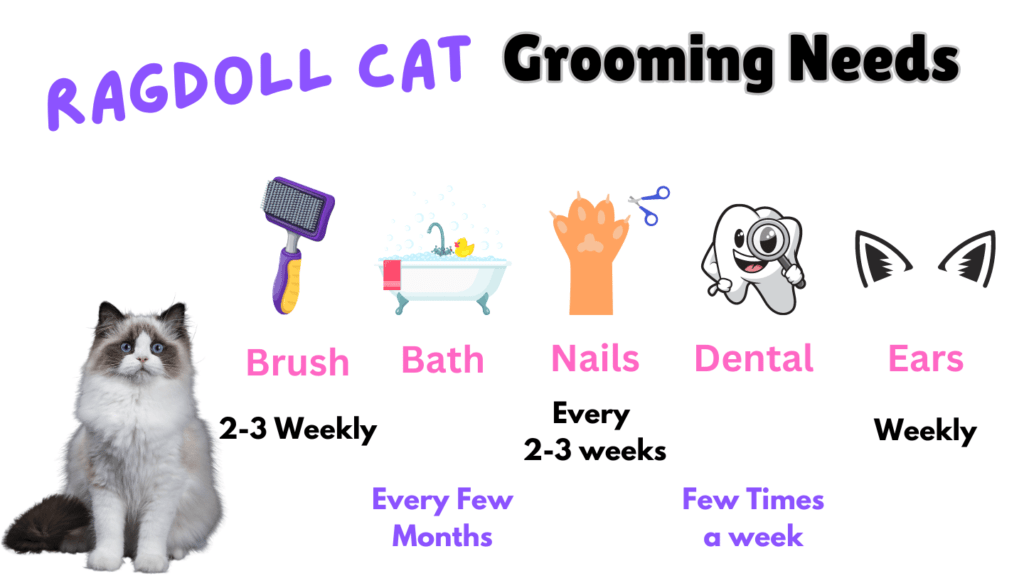
- Brushing: Start with a stainless steel comb to detangle and remove loose hair, at least twice a week. Follow up with a softer brush to give their coat a glossy finish and stimulate the skin.
- Bathing: While frequent baths are not necessary, occasional baths may be required if your cat becomes particularly dirty. Ensure the bath is gentle and stress-free.
- Claw Trimming: Keep their claws trimmed every few weeks to prevent overgrowth and protect both your cat and your furniture.
- Dental Care: Regular dental checks are crucial. Brush your Ragdoll’s teeth several times a week using a cat-specific toothpaste to prevent plaque buildup and maintain oral health.
- Ear Cleaning: Weekly, gently clean your Black Ragdoll’s ears with a vet-approved cleaner, massaging the base and wiping after they shake.
Conclusion: Embracing the Charm of Black Ragdoll Cats
Black Ragdoll cats share all the enchanting traits of their traditionally colored counterparts: they are calm, gentle, and incredibly sociable, making them ideal companions for any pet lover.
Despite their rarity and the rich, dark hue of their fur, Black Ragdolls exhibit the same “floppiness” that the breed is celebrated for, going completely limp and cuddly when picked up.
In many Western cultures, black cats have been surrounded by superstitions, often viewed less favorably. However, Black Ragdolls break through these myths with their endearing personalities and affectionate nature. They are just as likely to bring joy and companionship to their families as any other Ragdoll or pet.
Meet Sean, a fintech whiz with a penchant for pet purrs and blockchain buzz. After a decade of fintech feats, Sean’s tech talents leaped from ledger lines to litter lines, driven by a passion for pets and a vision for a more connected pet care community. With three critter companions as co-pilots, Sean launched this blog to share a treasury of pet-friendly tech tips and tales.

